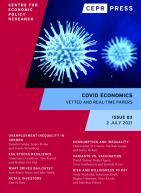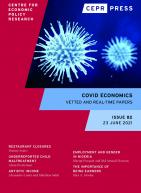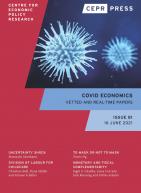
Infectious diseases, ideas, new products, and other “infectants†spread in epidemic fashion through social contact. The Covid-19 pandemic, the proliferation of “fake news,†and the rise of antibiotic resistance have thrust economic epidemiology into the forefront of public-policy debate and re-invigorated the field. Focusing for concreteness on disease-causing pathogens, this paper provides a taxonomy of economic-epidemic models, emphasizing both the biology / immunology of the disease and the economics of the social context. An economic epidemic is one whose diffusion through the agent population is generated by agents' endogenous behavior. I highlight properties of the Nash-equilibrium epidemic trajectory and discuss ways in which public-health authorities can change the game for the better, (i) by imposing restrictions on agent activity to reduce the harm done during a viral outbreak and (ii) by enabling diagnostic-informed interventions to slow or even reverse the rise of antibiotic resistance.
Citation
McAdams, D (2020), ‘Economic epidemiology in the wake of Covid-19‘, COVID Economics 48, CEPR Press, Paris & London. https://cepr.org/publications/covid-economics-issue-48#392514_392924_390618
Individualism has long been linked to economic growth. Using the COVID-19 pandemic, we show that such a culture can hamper the economy's response to crises, a period with heightened coordination frictions. Exploiting variation in US counties' frontier experience, we show that more individualist counties engage less in social distancing and charitable transfers, two important collective actions during the pandemic. The effect of individualism is stronger where social distancing has higher externality and holds at the individual level when we exploit migrants for identification. Our results suggest that individualism can amplify economic downturns by exacerbating collective action problems.
Citation
Xu, T, N Foutz, J Li and B Bian (2020), ‘Individualism During Crises‘, COVID Economics 48, CEPR Press, Paris & London. https://cepr.org/publications/covid-economics-issue-48#392514_392924_390619
We find that an entrepreneur's negative personal attitude towards debt – debt aversion – affects the financing decisions of the businesses they run. We conduct a large-scale survey of entrepreneurs and link it to their firms' registry-based financial information. After controlling for a range of observable traits, firms run by highly debt averse entrepreneurs are about nine percentage points less likely to use debt, compared to baseline debt usage of just under 50%. The same entrepreneurs are also almost 25% less likely to take up government-guaranteed debt during the COVID-19 crisis. We also conduct a set of experiments to strengthen a causal interpretation. The experiments randomize the framing of otherwise identical, hypothetical COVID-19 support policies as debt or grants. Framing policies as debt significantly decreases interest.
Citation
Pursiainen, V, S Torstila and M Paaso (2020), ‘Entrepreneur Debt Aversion and Financing Decisions: Evidence from COVID-19 Support Programs‘, COVID Economics 48, CEPR Press, Paris & London. https://cepr.org/publications/covid-economics-issue-48#392514_392924_390620
We study the effects of international supply chain disruptions on real economic activity and prices during the Covid-19 pandemic. We show that US sectors with a large exposure to intermediate goods imports from China contracted significantly and robustly more than other sectors. In particular, highly exposed sectors suffered larger declines in production, employment, imports, and exports. Moreover, input and output prices moved up relative to other sectors, suggesting that real activity declines in sectors with a high China exposure were not particularly driven by a slump in demand. Quantitatively, differences in China exposures accounts for about 9\% of the cross-sectoral variance of industrial production growth during March and April 2020. The estimated effects are short-lived effects and dissipate by July.
Citation
Pinto, E and M Meier (2020), ‘Covid-19 Supply Chain Disruptions‘, COVID Economics 48, CEPR Press, Paris & London. https://cepr.org/publications/covid-economics-issue-48#392514_392924_390621
Since COVID-19 broke out, there has been renewed interest in understanding the economic and social dynamics of historical and more recent epidemics and pandemics, from the plagues of Antiquity to modern-day outbreaks like Ebola. These events can have significant impacts on the interplay between poverty and social cohesion, i.e. how different groups in society interact and cooperate to survive and prosper. To that effect, this survey paper provides an overview of how social responses to past epidemics and pandemics were determined by the epidemiological and non-epidemiological characteristics of these outbreaks, with a particular focus on the scapegoating and persecution of minority groups, including migrants. We discuss existing theories as well as historical and quantitative studies, and highlight the cases where epidemics and pandemics may lead to milder or more severe forms of scapegoating. Finally, we conclude with a summary of priorities for future research on epidemics, pandemics and social cohesion and discuss the possible effects and policy implications of COVID-19.
Citation
Zaveri, E, J Russ, R Jedwab, A Khan and R Damania (2020), ‘Epidemics, Poverty, and Social Cohesion: Lessons from the Past and Possible Scenarios for COVID-19‘, COVID Economics 48, CEPR Press, Paris & London. https://cepr.org/publications/covid-economics-issue-48#392514_392924_390622
We forecast the short-term evolution of the Mexican economy after the COVID-19 shock. We take into account the fact that there is no similar shock observed in contemporaneous data. We combine an econometric procedure with a basic SIR model of the pandemic. To make the forecasts we first calculate an estimate of the shocks that hit the economy starting in March 2020. We then produce several forecasts in which we make variations on two dimensions: introducing a path for the pandemic or not, and if we do, we consider three scenarios. The introduction of paths of the pandemic in which new cases fall has a positive effect on the economy. The main results are the following. First, the shocks that hit the economy starting in March 2020 have the potential to produce a slow recovery of economic activity. In a forecast not conditioned on any path for the pandemic, the annual growth rate of the economy recovers positive values in the second quarter of 2021. Second, in our baseline scenario that includes a pandemic path based on the SIR model, the recovery is faster, having positive growth rates in the first quarter of 2021. To maximize the benefits of a fall in new cases, policy makers should reduce persistent effects of the initial shock that hit the economy. Otherwise economic activity would tilt towards a longer recession.
Citation
Meza, F (2020), ‘Forecasting the Impact of the COVID-19 Shock on the Mexican Economy‘, COVID Economics 48, CEPR Press, Paris & London. https://cepr.org/publications/covid-economics-issue-48#392514_392924_390623
Background: Risk communication is a key component of public health interventions during an outbreak. As the coronavirus pandemic unfolded in late 2019, the World Health Organization (WHO) was at the forefront in the development of risk communication strategies. The WHO introduced a range of activities with the purpose of enabling the public to avail verified and timely information on COVID-19 prevention behaviors. Given the various WHO activities to protect the public health during COVID-19, it is important to investigate the extent of familiarity and uptake of the WHO recommendations among the public so far during the pandemic. Methods: To do this, we conducted a large-scale Pan-European survey covering around 7500 individuals that are representative of populations from seven European countries, collected online during April 2-April 15, 2020. We use descriptive statistics including proportions and correlations and graphical representations such as bar charts to analyze and display the data. Results: Our findings suggest that information from the WHO in the context of COVID-19 is well trusted and acted upon by the public. Overall familiarity and adherence were quite high in most countries. Adherence was higher for social distancing recommendations compared to hygiene measures. Familiarity and adherence were higher among older, female, and highly educated respondents. However, country level heterogeneities were observed in the level of trust in information from the WHO, with countries severely affected by the pandemic reporting lower levels of trust. Conclusion: Our findings call for efforts from health authorities to get regular feedback from the public on their familiarity and compliance with recommendations for preventive measures at all stages of the pandemic, to further develop and adapt risk communication as the pandemic evolves.
Citation
van Exel, J, N Varghese, T Stargardt, A Torbica, J Schreyögg, I Sabat, S Neumann-Bohme, W Brouwer and P Barros (2020), ‘Risk Communication during COVID-19: Familiarity with, Adherence to and Trust in the WHO Preventive Measures‘, COVID Economics 48, CEPR Press, Paris & London. https://cepr.org/publications/covid-economics-issue-48#392514_392924_390624
The unprecedented crisis caused by the coronavirus pandemic has prompted a spontaneous collective effort by the economics profession to contribute both to the immediate policy response to the shock, and also to the debate about the character of the subsequent recovery. This paper describes the current contributions of economists, largely from a UK perspective, and compares – and contrasts – this episode with the activities of economists during WW2. In both cases economists have collectively responded to crisis demands with a strong sense of public service. There are also key differences, including the presence of a formal economics profession in government now in contrast to the earlier period, and also prior critiques of economics as a discipline since at least the 2008 financial crisis. The second world war led to significant innovations in economics and its professional status; the scale of the current crisis may in turn lead to an evolution in the professional character of the discipline.
Citation
Coyle, D (2020), ‘From villains to heroes? The economics profession and its response to the pandemic‘, COVID Economics 48, CEPR Press, Paris & London. https://cepr.org/publications/covid-economics-issue-48#392514_392924_390625


Covid Economics - Issue 82
- Restaurant Closures during the Pandemic: A Descriptive Analysis
- Underreporting Child Maltreatment during the Pandemic: Evidence from Colorado
- Covid-19 impact on Artistic Income
- COVID-19, Employment, and Gender: Evidence from Nigeria
- The Importance of Being Earners: Modelling the Implications of Changes to Welfare Contributions on Macroeconomic Recovery
